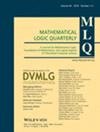有限单调数的罗杰斯半格
IF 0.4
4区 数学
Q4 LOGIC
引用次数: 0
摘要
有限单调集和函数是可计算结构理论中的一个重要工具。我们研究了有限单调数。一族S∧P(ω) $S\subset P(\omega )$的编号ν是有限单调的(l.m.),如果每个集合ν(k) $\nu (k)$是一个有限单调函数的值域,一致地在k中。S的所有l.m.编号的集合归纳出罗杰斯半格Rlm(S) $R_{lm}(S)$。半格Rlm(S) $R_{lm}(S)$表现出一种特殊的行为,使它们介于经典Rogers半格(可计算族)和Σ20 $\Sigma ^0_2$可计算族的Rogers半格之间。我们证明了Σ20 $\Sigma ^0_2$‐可计算族的每一个Rogers半格都与某个半格rm (S) $R_{lm}(S)$同构。另一方面,经典罗杰斯半格存在无穷多个同构类型,它们可以被实现为半格Rlm(S) $R_{lm}(S)$。特别地,存在一个l.m.s族S,使得Rlm(S) $R_{lm}(S)$同构于c.e.m°的上半格。证明了如果一个l族S包含多于一个元素,则偏置集Rlm(S) $R_{lm}(S)$是无限的,并且它不是格。在所有Σ20 $\Sigma ^0_2$‐可计算编号的类中,l.m.编号形成了一个理想(编号之间的w.r.t.可约性)。证明了在这个类中,l.m.编号的索引集是Σ40 $\Sigma ^0_4$‐完备的。本文章由计算机程序翻译,如有差异,请以英文原文为准。
Rogers semilattices of limitwise monotonic numberings
Limitwise monotonic sets and functions constitute an important tool in computable structure theory. We investigate limitwise monotonic numberings. A numbering ν of a family S⊂P(ω)$S\subset P(\omega )$ is limitwise monotonic (l.m.) if every set ν(k)$\nu (k)$ is the range of a limitwise monotonic function, uniformly in k. The set of all l.m. numberings of S induces the Rogers semilattice Rlm(S)$R_{lm}(S)$ . The semilattices Rlm(S)$R_{lm}(S)$ exhibit a peculiar behavior, which puts them in‐between the classical Rogers semilattices (for computable families) and Rogers semilattices of Σ20$\Sigma ^0_2$ ‐computable families. We show that every Rogers semilattice of a Σ20$\Sigma ^0_2$ ‐computable family is isomorphic to some semilattice Rlm(S)$R_{lm}(S)$ . On the other hand, there are infinitely many isomorphism types of classical Rogers semilattices which can be realized as semilattices Rlm(S)$R_{lm}(S)$ . In particular, there is an l.m. family S such that Rlm(S)$R_{lm}(S)$ is isomorphic to the upper semilattice of c.e. m‐degrees. We prove that if an l.m. family S contains more than one element, then the poset Rlm(S)$R_{lm}(S)$ is infinite, and it is not a lattice. The l.m. numberings form an ideal (w.r.t. reducibility between numberings) inside the class of all Σ20$\Sigma ^0_2$ ‐computable numberings. We prove that inside this class, the index set of l.m. numberings is Σ40$\Sigma ^0_4$ ‐complete.
求助全文
通过发布文献求助,成功后即可免费获取论文全文。
去求助
来源期刊
CiteScore
0.60
自引率
0.00%
发文量
49
审稿时长
>12 weeks
期刊介绍:
Mathematical Logic Quarterly publishes original contributions on mathematical logic and foundations of mathematics and related areas, such as general logic, model theory, recursion theory, set theory, proof theory and constructive mathematics, algebraic logic, nonstandard models, and logical aspects of theoretical computer science.

 求助内容:
求助内容: 应助结果提醒方式:
应助结果提醒方式:


